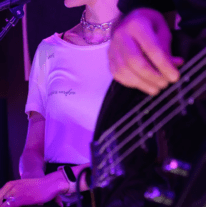
Regular TNOCS readers might remember that I went to the 2022 Amigo Guitar Show in Franklin, Tennessee.
I went again last weekend and it was even bigger this time around.
There were lots of Gibsons and Fenders, of course. And quite a few surprises.
For instance, I expected a lot of Fender Stratocasters….

…but I didn’t expect a row of Fender Duo-Sonics and Mustangs:


In 2022, there were many harp guitars. This year, there was only one, but it was a beauty.
This year there were two other trends. “Trends” is probably the wrong word because the dealers come from all over the country and they’re selling mostly vintage instruments. I doubt they talk beforehand and agree to bring a particular kind of guitar.
It’s not like the fashion industry choosing a particular shade of green for their spring collections. Vintage instrument dealers buy guitars as they become available, so maybe the trends are based on what collectors decided to sell to the dealers. I really don’t know.
At any rate, the first trend I noticed was plexiglass guitars. These have been around since the 1960s. They’re heavy and scratch easily, but they look cool and always match your outfit.

This is a 1998 reissue of the 1960s Ampeg Dan Armstrong bass. It’s in really good condition and the asking price was $1,999.
This Dan Armstrong guitar is all original.

The plexiglass has some light scratches resulting in a slightly frosted look, but it’s in really good shape considering it’s over 50 years old. It can be yours for $4,999.
And here we have a BC Rich Mockingbird in green plexiglass. While the neck is wood, the headstock is also plexiglass.

I’m not sure how the wood and plastic are joined but I don’t know if I’d need to worry about breakage. Only $1,200.

There were, in fact, two lime green Mockingbirds. This one and its friend, the red plexiglass BC Rich Warlock, are both priced at $1,299.
The other trend was decorated guitars.
These also have their roots in the 1960s when Fender made guitars and basses with pink paisley and blue floral patterns. It was, like, psychedelic, man.
This Telecaster in blue floral is a 1996 reissue priced at $2,000.

Notice that the pickguard is transparent plastic so you can see the pattern underneath.

And that clear pickguard protected the pink paisley on this 1969 Telecaster while the exposed portion of the paisley faded into orange and yellow. Still, based on the year and lack of modifications, it’s probably worth the $18,250 on the tag.

The change in color is even more noticeable on this Telecaster bass.
Next to this fairly recent pink paisley Telecaster is a no-name tribute to Eddie Van Halen:

With no logo on the headstock, it looks like someone built it from parts they had lying around. That’s just a guess.
Also in the decorated guitar category, we have this 1985 PRS Metal listed at $9,500.

I’m not familiar with this model but after doing a little research, I’ve discovered why the price is so high, and yet it’s a bargain. Only 35 were made, and there’s one listed online at the reduced price of $17,999.
This is not an intentionally psychedelic paint job you’re looking at.

It’s a material called Fordite, because it’s hundreds of layers of automotive paint from the floor of the Ford assembly line. Decades ago, people realized you can peel these layers of dried, over-sprayed paint off the assembly line tracks and make jewelry.
Warrior Guitars decided to get larger pieces and glue them to wood bodies to make these decorative tops. As they’re sanded and polished, new colors appear. Naturally, no two are alike. This one is priced at $10,799.
These Lyman guitars, however, are hand painted.


This is the Waylon Jennings Telecaster. It was a limited edition, but there were several at the show. They were all right around this $4,499 price.

I can’t decide whether this white pearloid Stratocaster with a white pearloid pickguard is ugly or beautiful. I think I like it.
This Stromberg Voisinet is from the 1930s. It’s in great shape for such an old instrument and is only $900.


This 1918 Martin 2-17, on the other hand, is probably appropriately priced at $3,500, despite heavy wear and tear. 2-17’s in good condition go for about $5,000.
Given the low price, I almost think these decorated guitars are more for hanging on the wall than for playing:

Let’s move on to some instruments outside of those two categories. These are just interesting on their own.

You might recognize this shape from Rickenbacker basses, but this model 481-S from 1974 is a six string guitar.
If you look closely, you’ll notice that the frets aren’t at a 90° angle to the edge of the neck. They’re slightly slanted. The theory behind this design is that the left wrist won’t have to twist as much. It’s a sensible idea, but it didn’t really catch on.
However, take a look at the frets on this black Dingwall NG3 bass. They’re also slanted but in a fanned layout, so the lowest string is longest and the highest string is shortest.

The wrist would have to twist more on this one.
So why did they do it? The longer the string, the less it has to be tightened to be tuned to its note, and bass strings need a lot of tension to reach their pitch. That puts stress on the bass’s neck and alters the string’s tone. So having less tension on the longer strings solves both those problems.
That’s why the sound of these Dingwalls have been called “the voice of God.” This one was reasonably priced at $2,999.
This BC Rich has a 6-string neck and a 12-string neck:

The innovative design here is that half of the tuners on the 12-sting are in the traditional location on the headstock, and the other six are at the far end of the body. This prevents the headstocks from getting too heavy, so the instrument balances better on a strap. Two guitars for the price of one at $1,699.
This 1989 Kubicki Factor bass also has its tuners on the body. This allows it to have an interesting feature on the low E string. There’s a small switch holding the string down at the nut. Release the switch and you get two more notes on that string, so it goes down to a D.

It’s been restored so it looks brand new, but in the guitar world there’s a premium on originality. If it hadn’t been altered, it might be worth $5,000, so the $6,000 asking price is perhaps a little optimistic.
The DG-20 by Casio (yes, the watch people) was a synthesizer for guitar players. Made out of plastic with nylon strings, it plays like a guitar but sounds like a synth.

It also had a built-in drum machine and a MIDI output so you could use it with any synth module, which means it wasn’t limited to its internal sounds.
While there are some pretty good guitar synths out there, most had a problem with a lag between the time you hit the note and the time you heard it. It might have been only a couple milliseconds difference, but they were disconcerting to play.
Anyway, the price range on these is from $400 to $800 depending on condition and accessories.
The body on this Danelectro might look small, but it’s the neck that’s long. This is a baritone guitar, tuned midway between a bass and a standard guitar.

That means its lowest note is a B, not an E. Some people, especially session players, tune them to C because it’s more useful in studio settings.
This particular one is from 2015 and the dealer said it’s been in its original box since he bought it. He’s played it a couple times but for all practical purposes, it’s brand new. $525 seems like a good price.
And finally, while I took many more pictures, I’ll leave you with this “Tribute To Prince” guitar.

It’s as purple as purple can be and has that shape we all know, though the headstock isn’t the same arrowhead design that Prince’s had.
The asking price was $4,900. Unfortunately, Prince’s talent isn’t included. Still, it’s eye-catching.
I’m really glad I went to the show and will most certainly go again next year.
It’s always a fun day. So even though I didn’t buy anything, I didn’t walk out empty handed.
I walked out with a smile.
Let the author know that you liked their article with a “Green Thumb” Upvote!





Some great looking guitars as well oddities like that synth guitar. Think the Fordite is my favourite in terms of aesthetics.
I don’t recall seeing anyone playing a plexiglass guitar. They do look cool but are they actually any good sound wise and to play? Given you said they’re heavy and Scratch easily suggests they’re far from practical.
We’re you able to try any out, or given the prices of some do you need to provide proof of funds before you’re allowed to touch them?
Lots of people used the Ampeg Dan Armstrongs, but I don’t think anyone used it as their main instrument. Keith Richards, Bill Wyman and possibly Ronnie Wood from the Stones played them, as did Joe Walsh, Tom Verlaine, Dave Grohl, and many others. According to this article, Paul McCartney supposedly has the only left-handed Dan Armstrong guitar.
Yes, anyone can try the instruments, though you need to talk to the dealer first. Just grabbing a guitar off its stand would be poor etiquette. I didn’t play anything because I was actually in the market for parts. I’m modifying one of my basses and it needs new tuners, knobs and maybe pickups. Didn’t find any that would fit so all I got was pictures.
Turns out the story about McCartney’s left-handed guitar is true. Pictures here.
Plexiglass guitars give longer sustain. They can sound tinny compared to wood guitars, especially if the guitarist isn’t accustomed to them. They are ungodly heavy, at least double the weight of any wood body guitar.
Any CBGs at the show?
That Fordite is funky.
Cigar box guitars? I didn’t see any there but I know a guy who makes them. Check out Bowlin’s Box Instruments.
Loved this article. It was almost like it was in English for the most part, but veered into “guitarese” at times. Can’t really say that it’s niche, but you know how much I love people who are excited by interests that I don’t share.
Cool! Seems like this is the place to really guitardone!
OK. Finally a chance to try out my original and tangentially related pun:
“I know a guy who is the absolute best guitar repair and restoration craftsman that you will ever meet. He is particularly renowned for his expertise when working on the legendary instruments that hail from Nazareth, Pennsylvania.
“They call him: The Martin Luthier King.”
{Ducks incoming fruit barrage}
Ouch!
(For those that don’t know, Nazareth is home to Martin Guitars.)
This is a terrible joke. I like it.
I rode in to Nazareth
Just feelin’ bout half past dead
Need to find a place
Where I can lay my head
That Fordite guitar blew my mind. I had to show it to Mrs. Pauly. It’s a work of art!
The baritone guitar struck my fancy as well but more out of curiosity. Seems like with different tuning than either a regular guitar or a bass, it would be a different animal entirely to develop skill and competency.
I love these articles, V-dog… a feast for the eyes!